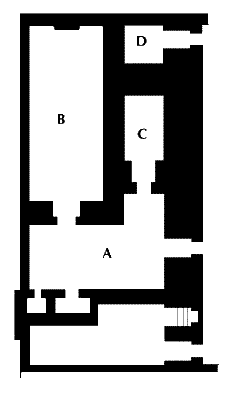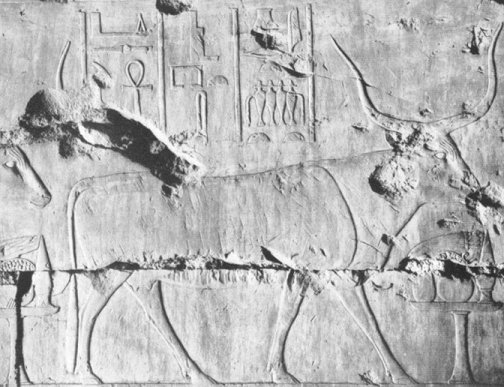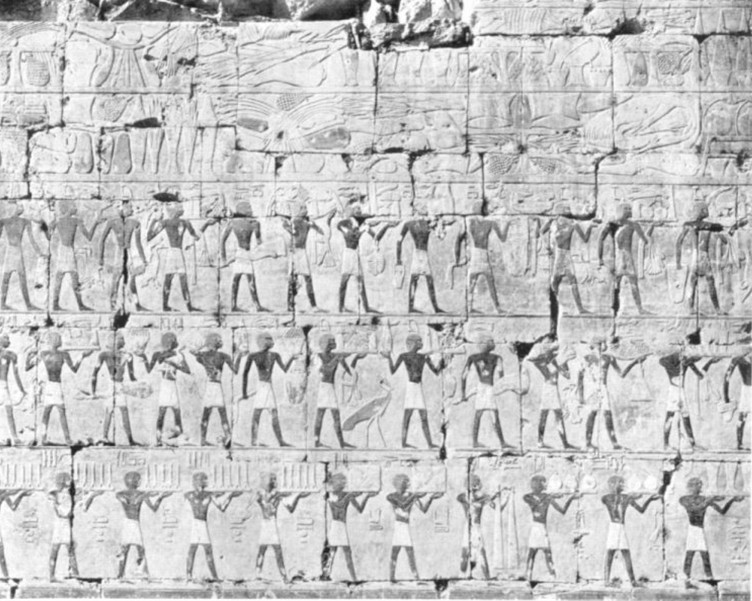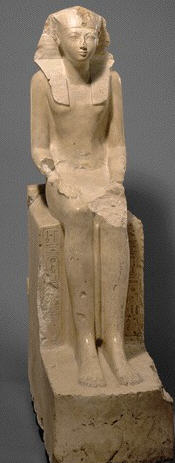|

| Ground-floor plan of the Chapels of Hatshepsut and her
father, Thutmosis I |
| A. Vestibule; east of - i.e. in front of - the vestibule there
is the room with the window. |
| B: Chapel of Hatshepsut; |
| C: Chapel of Thutmosis I; |
| D: Chapel of the ithyphallic Amun; |
| The cult chapels of Hatshepsut and her father,
Thutmosis I, could be entered only from the upper terrace through
the gate leading to the vestibule. A row of three columns supported
the ceiling of the vestibule. Both entrances to the chapels are in
the western wall of the vestibule. Two small niches had been built
into the eastern wall of the vestibule, one of these had been
decorated with Chapter 148 of the Book of the Dead. This chapter
should ensure the supply with food in the afterworld thanks to
knowing the names of the 7 celestial cows (see photo below from
Werbrouck, 1949) and their bull. Therefore,
these cows had been depicted on the western wall of the niche. The
other niche showed offerings to 9 mummiform gods (among them Atum,
Re-Horakhti, Horus, Sobek, Djet and Neheh). |

| The offering hall of the Chapel of Hatshepsut had
been the most impressive room in the entire temple due to its
exceptionally rich decoration. A torus run all around the upper
border of the walls. The Hall of Offerings had been covered by a
vaulted roof.
|
| The western wall of the hall (see photo below from
Werbrouck, 1949) had been decorated with a large false-door made of red granite.
Investigations of the Polish team revealed that the original decoration of the stela
was completely chiseled away and covered with plaster in Coptic times
(Barwik, PAM 2001. |

The lateral walls were decorated from
bottom to top with a procession of noblemen and priests carrying
offerings (see photo below from Werbrouck, 1949) , above the procession there were three registers full with
offerings. On both lateral walls the Iun-mut-ef-priest was
officiating the ceremonies.
Furthermore, the walls showed
excerpts of the Pyramid Texts which had the same
"function" as the Chapter 148 of the Book of the Dead - to
ensure the supply with goods and to protect the deceased in the afterworld. |
The lateral walls were decorated from
bottom to top with a procession of noblemen and priests carrying
offerings (see photo below from Werbrouck, 1949) , above the procession there were three registers full with
offerings. On both lateral walls the Iun-mut-ef-priest was
officiating the ceremonies.
Furthermore, the walls showed
excerpts of the Pyramid Texts which had the same
"function" as the Chapter 148 of the Book of the Dead - to
ensure the supply with goods and to protect the deceased in the afterworld. |

| The ceiling of the hall was covered with yellow stars
on a dark blue sky. Furthermore, there had been depictions of the Ritual
of Hours (Day and Night), each scene showed Hatshepsut in front of
goddesses personifying a particular hour. Only the western part
of the ceiling and the western part of the gable (Greek: tympanum)
have been preserved. The western tympanum shows the solar bark with
Hatshepsut accompanied by Atum, Isis and Nephtys. |
 |
The Chapel of Hatshepsut was her
residence on earth - probably her seated statue now on show in the
Metropolitan Museum of Art, New York (photo left), had stood here.
Furthermore, a
statue most likely made of wood which was used in ceremonies at
other chapels of the temple had been kept here.
|
|




